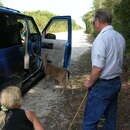Biology
provided by Arkive
Key deer are most active during the late evening, night and early morning (3). The diet varies depending on the season as, different plants become available and as nutritional requirements change (2). They feed on over 160 plant species, but the red mangrove (Rhizophora mangle) is a particular favourite (4) (3).
The breeding season (known as the rut) takes place from September to December and January, but peaks in October (3) (2). Key deer are known to produce, on average, fewer young than any other populations of white deer in North America, possibly because of a deficiency in phosphorous or as an evolutionary adaptation to a restricted environment (2).
During the rut, bucks fight with their antlers in order to gain dominance and the right to breed (3). The antlers are shed in February or March, and a new set starts to grow almost straight away. The new antlers will be fully grown by August and the velvet surrounding them will have been rubbed off by September (3).
After mating, the gestation period lasts around 7 months (3). Most fawns are produced in the rainy season in April or May (4), ensuring that there is plenty of food available for the females whilst they are suckling their young (2). Males tend to disperse away from the area of birth as fawns or as yearlings, but females often stay with their mother, forming loose matriarchal groups consisting of the mother and several generations of her daughters (2).
Conservation
provided by Arkive
The Key deer was officially listed as federally Endangered throughout its range in 1967 (2). Much of the range of the Key deer falls within the boundaries of the National Key Deer Refuge and Great White Heron National Wildlife Refuge, both of which are managed for Key deer and other endangered species (2). Roadkills are being tackled by establishing speed zones and erecting warning signs at deer crossing points (2). A local citizens' group, the Key Deer Protection Alliance, is working to increase public education and awareness, and supports action projects and habitat preservation (2). As human populations continue to increase, it is likely that habitat loss to development will continue and road mortalities will rise. The future of this diminutive deer will unfortunately remain uncertain, providing that the threats it faces continue (2).
Description
provided by Arkive
The Key deer is the smallest subspecies of the white-tailed deer in North America, and is sometimes called 'toy deer' due its small size (3). When compared to other white-tailed deer, Key deer are shorter and stockier, with shorter legs and a wider skull (2). The coat colour ranges from deep reddish brown to grey, and a dark mask or cross is often present between the eyes and on the brow (3). Bucks (males) typically develop forked antlers by their second year (4); these antlers will normally have eight points by the fourth year of life (2). The Key deer was first recognised as a distinct subspecies in 1922 (2).
Habitat
provided by Arkive
Although they are able to tolerate some levels of salt in their drinking water, Key deer require a permanent source of freshwater in the habitats in which they live, in order to survive (4) (2). They use all types of habitat within the range, including pine woodlands, pine rocklands, and various types of wetland (2). Pine rocklands are especially important as they contain sources of freshwater (2). The deer also make use of residential areas, where they take refuge from biting insects and feed on ornamental plants (2).
Range
provided by Arkive
It is thought that Key deer were isolated from the mainland between 6 to 12 thousand years ago when the glaciers retreated (3). They are endemic to the Florida Keys of Monroe County, Florida, in the United States (4). The current range of the deer includes around 26 islands from Big Pine Key to Sugarloaf Key, with Big Pine Key forming the stronghold, supporting around two-thirds of the population (2).
Status
provided by Arkive
Classified as Endangered (EN D) by the IUCN Red List 2003 (1).
Threats
provided by Arkive
The Key deer had a very close brush with extinction in the late 1940s as a result of over-hunting; by the start of the 1950s there were just 25 deer remaining (2). Well-enforced bans on hunting and protection from disturbance allowed the population to slowly recover to 579-678 individuals in 1998. Unfortunately, habitat destruction and human-caused mortality and disturbance continue to pose threats to the survival of the Key deer. The main threat facing this deer at present is habitat loss and fragmentation. Fencing and increasing development forces the deer to cross roads where they are at risk from traffic, and can prevent them from being able to reach water sources (2). Important food plants and habitats are being affected by introduced plants, which are out-competing the native species. Roadkills are the biggest source of mortality, responsible for over 50% of deaths (3). Other causes of deaths include poaching, running by dogs, drowning in ditches, entanglement in fences, and feeding in rubbish bins, which often results in foreign bodies becoming caught in the digestive tract (2). Humans often illegally feed the deer, which affects their natural patterns of movement, causes them to lose their fear of humans and increases susceptibility to parasites and disease (3). Furthermore, this deer is highly susceptible to losses caused by chance events such as hurricanes and sea-level rise, because of its restricted distribution (2).

